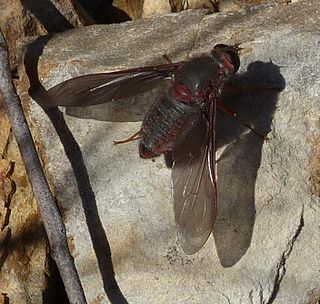
The lesser stick-nest rat or white-tipped stick-nest rat is an extinct species of rodent in the family Muridae. It lived in central Australia where it built nests of sticks that accumulate over years and can become very large. The last confirmed sighting of this rat was in 1933 although there is a credible report of a sighting in 1970. In 2008, the International Union for Conservation of Nature listed it as "critically endangered", suggesting that it may yet survive in remote areas of unsurveyed territory, but revised its evaluation to "extinct" again in 2016, based on an assessment in 2012.

Dibbler is the common name for Parantechinus apicalis, an endangered species of marsupial. It is an inhabitant of the southwest mainland of Western Australia and some offshore islands. It is a member of the order Dasyuromorphia, and the only member of the genus, Parantechinus. The dibbler is a small, nocturnal carnivore with speckled fur that is white around the eyes.

The inland thornbill, called the broad-tailed thornbill, is a small, insect-eating bird of Australia. The inland thornbill is commonly confused with the coastal brown thornbill due to its similar colorations. The inland thornbill encompasses four subspecies:

The apical flycatcher is a species of bird in the family Tyrannidae.

Beringa Reserve, formerly known as Peniup Creek Reserve, is a 25.06 km2 nature reserve in south-west Western Australia. It lies about 380 km south-east of Perth. It is owned and managed by Bush Heritage Australia (BHA), by which it was purchased jointly with Greening Australia (WA) in 2007, and forms part of the Gondwana Link project, in which BHA is a partner.
Nectomys apicalis, also known as the western Amazonian nectomys, is a semiaquatic species of rodent in the genus Nectomys of family Cricetidae. It is found east of the Andes in Ecuador, Peru, and Bolivia, east into western Brazil; further to the east, it is replaced by N. rattus. It lives near watercourses in lowland tropical rainforest. Its karyotype has 2n = 38–42, and it probably actually represents several distinct undescribed species.
Erygia is a genus of moths in the family Erebidae erected by Achille Guenée in 1852.

Penicillifera apicalis is a moth of the family Bombycidae first described by Francis Walker in 1862. It is found from the north-eastern parts of the Himalaya to Sundaland and the Philippines.
Ancillina apicalis is a species of small sea snail, marine gastropod mollusk in the family Olivellidae, the dwarf olives.
Copelatus apicalis is a species of diving beetle. It is part of the genus Copelatus in the subfamily Copelatinae of the family Dytiscidae. It was described by Fairmaire in 1898. Copelatus apicalis is distributed along the coastline of much of Africa.
Pyrausta apicalis is a moth in the family Crambidae. It was described by George Hampson in 1913. It is found in South Africa, Swaziland and Zimbabwe.

Erygia apicalis is a moth of the family Erebidae first described by Achille Guenée in 1852. It is found from the Indo-Australian tropics of India, Sri Lanka to Japan, Australia and the Solomon Islands. The habitat consists of lowland areas, including dry heath forests and softwood plantations.
Parapsyche apicalis is a species of netspinning caddisfly in the family Hydropsychidae. It is found in North America.
Isodontia apicalis is a species of thread-waisted wasp in the family Sphecidae.
Atomaria apicalis is a species of silken fungus beetle in the family Cryptophagidae. It is found in Europe & Northern Asia and North America.
Catorhintha apicalis is a species of leaf-footed bug in the family Coreidae.

Comptosia is a genus of bee flies. There are at least 62 described species including the common Australian insects Comptosia apicalis, Comptosia neobiguttata and Comptosia insignis.

Comptosia quadripennis is a species of bee flies in the family Bombyliidae.

Comptosia insignis is a species of bee flies in the family Bombyliidae.









